In December 2024, my wife Diane and I spent a week on a guided kayaking trip departing from La Paz on the Baja Peninsula. Our adventure took us around the uninhabited Isla Espiritu Santo, a UNESCO Biosphere Reserve located in the Gulf of California — known also as the Sea of Cortez, which Jacques Cousteau called the “world’s aquarium.”
Our group consisted of 13 paddlers, all but one of whom were Canadian, and our two Mexican guides. Diane and I did not know any of the others when we joined the trip.
Our Guides
Our Mexican guides, Tulio and Antonio, were confident and friendly.
Tulio had 20 years’ experience. Nothing fazed him. When I broke a tent pole in the wind, he took it in stride, repairing it with a collar. When I did it again the next day, he laughed and improvised a way to make it work.
We relied on Tulio for route planning. Each evening, he gathered us to go over tomorrow’s plan. Sometimes there was a plan B, depending on the weather.
Antonio had been guiding for ten years. When not guiding, he told us he lives in a place with no electric power. He joked that he feels most comfortable camping. Sometimes he goes to Tulio’s house to charge his devices.
Both guides spoke excellent English. When chatting together they reverted to Spanish, and I enjoyed trying to figure out what they were talking about.
The routine
Each morning, we woke at sunrise, breakfasted at 7 a.m., broke camp, and launched by 9 a.m. Then we paddled along the coast to the next pristine white sand beach. Middays were spent snorkelling in crystal-clear waters, helping our guides prepare lunch (the trip was “co-operatively catered,” meaning we pitched in with food preparation), or exploring via short hikes inland.
After lunch, we paddled to our next campsite, another pretty bay with a sandy beach. While the guides prepared appetizers and drinks, we set up our tents. In this pleasant way, we covered about a dozen kilometres a day.
Hazards
The major hazards here were wind and sun. A wind in the wrong direction can make paddling virtually impossible, as we would find out. And protection from the sun was essential. A quick-dry long-sleeved hoodie, a cap, a quick-dry buff, paddling gloves, and sunglasses protected most of our exposed skin. On shore, the shade tarp went up first. Unlike on the BC coast, we didn’t need to worry about bears. Food was kept overnight in kayak hatches to keep out birds and small animals.
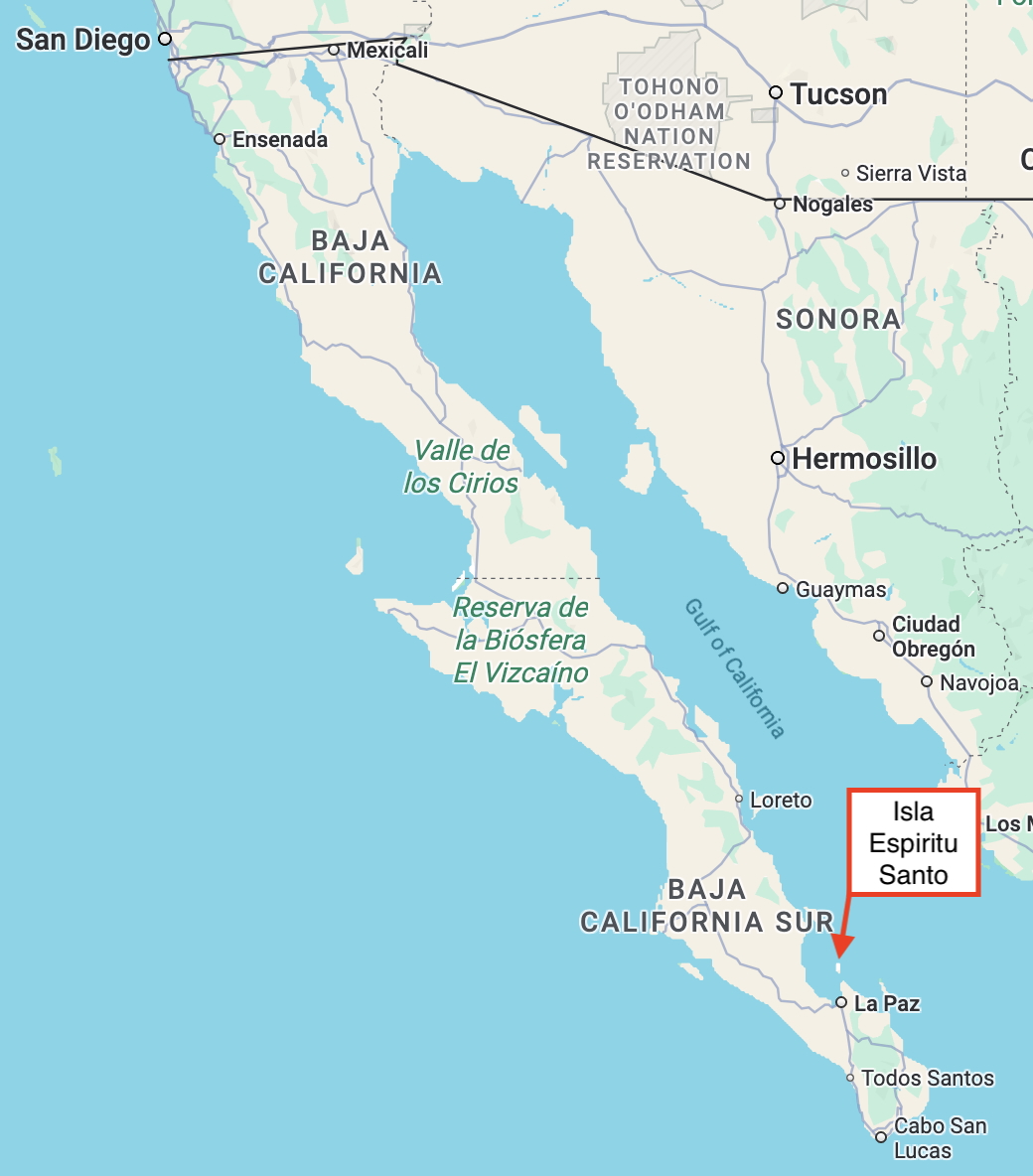
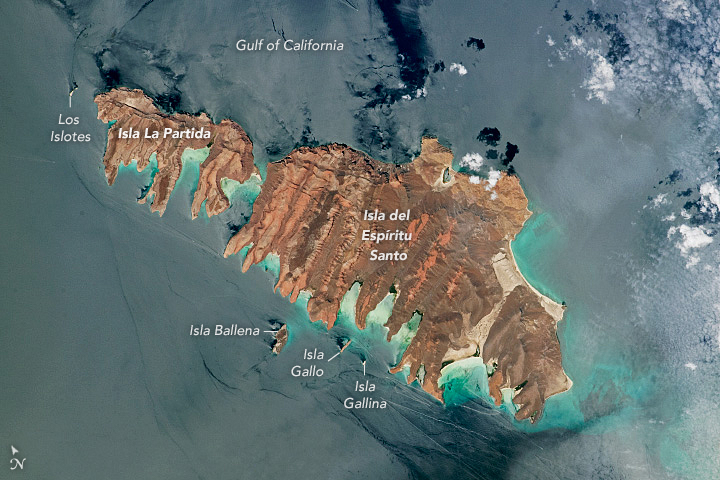
Arrival
The first night, we settle into a hotel on the La Paz waterfront. There, we meet one of our guides, Tulio, for a pre-trip briefing. Six of us are from BC, three from the Yukon, two from Ontario, one from Nova Scotia, and one from England. Amongst us are three physicians, four off-duty wilderness guides, and one wildlife biologist. All will contribute their skills and knowledge to the success of our trip.
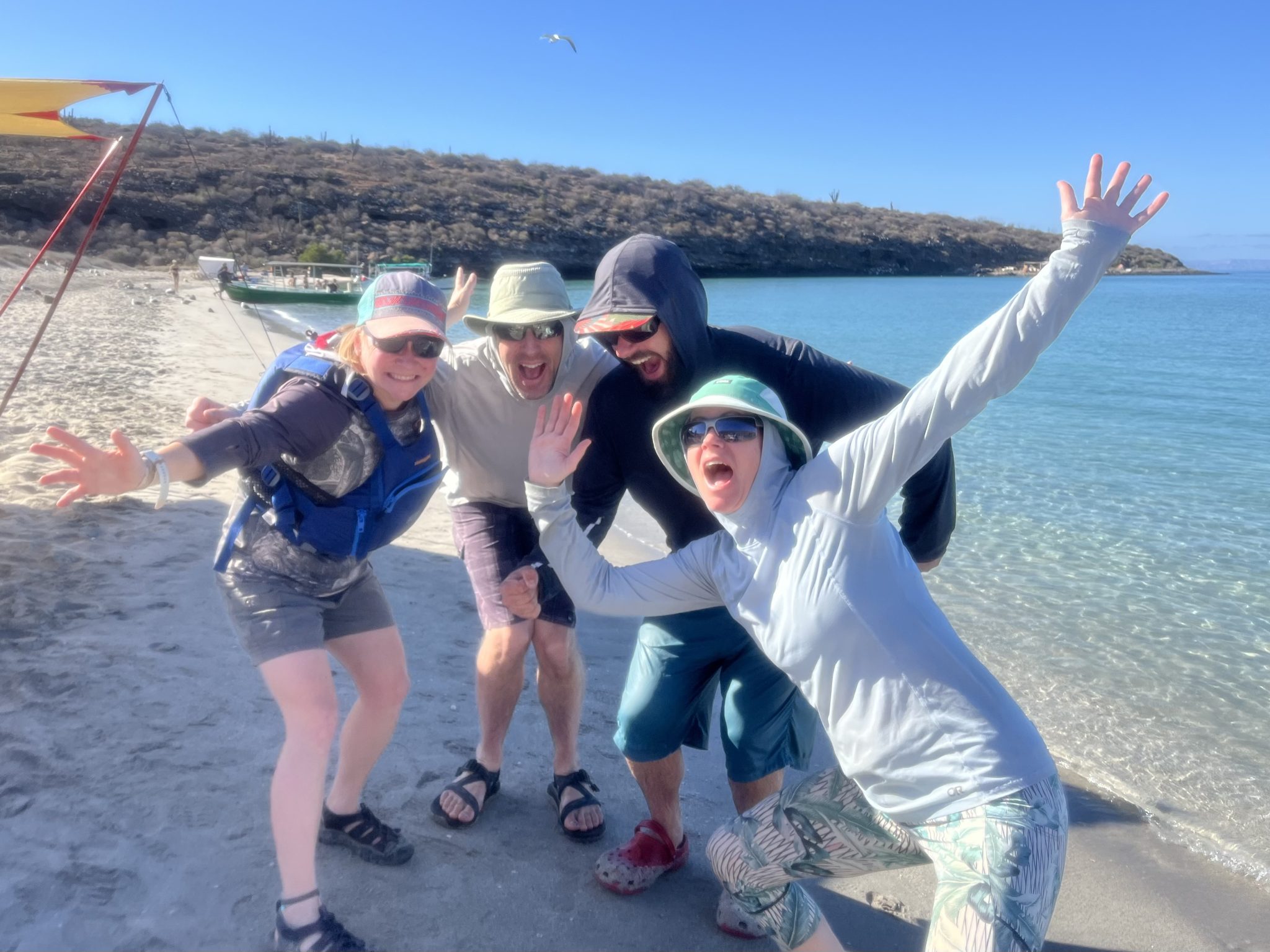
Day 1: 11 km
We breakfast at the hotel, pick up tents, chairs, wetsuits, and snorkel gear, and then board a panga (motorboat), which drops us at the south end of the island, where our kayaks await. The four doubles and seven singles are Canadian-made fibreglass boats by Seaward and Current Designs. We are each assigned one rear hatch for our personal gear. Front hatches are reserved for group gear and food. Each kayak carries a 10L dromedary bag of water.
Antonio gives us a safety talk and supervises as we each complete a wet exit. Then we eat lunch and set off.
We are paddling the west coast of the island, a series of beautiful bays with white sand beaches. As we paddle, clouds of magnificent frigate birds with their distinctive forked tails circle in thermals high above. Tiny sardines jump around us.
After two and a half hours of paddling, we arrive at our first campsite. We set up our tents on the beach, and learn how to use sand anchors in place of pegs. Before dinner, there is time to snorkel. Hundreds of colourful fish congregate around the corals – some with horizontal silver and black stripes, some with vertical black and yellow stripes.
We gather at happy hour for margaritas prepared by our guides. Dinner is a delicious fish stew and tacos. We enjoy the sunset and sit chatting and getting to know our companions. Our guides tell us of the plan for the next day.
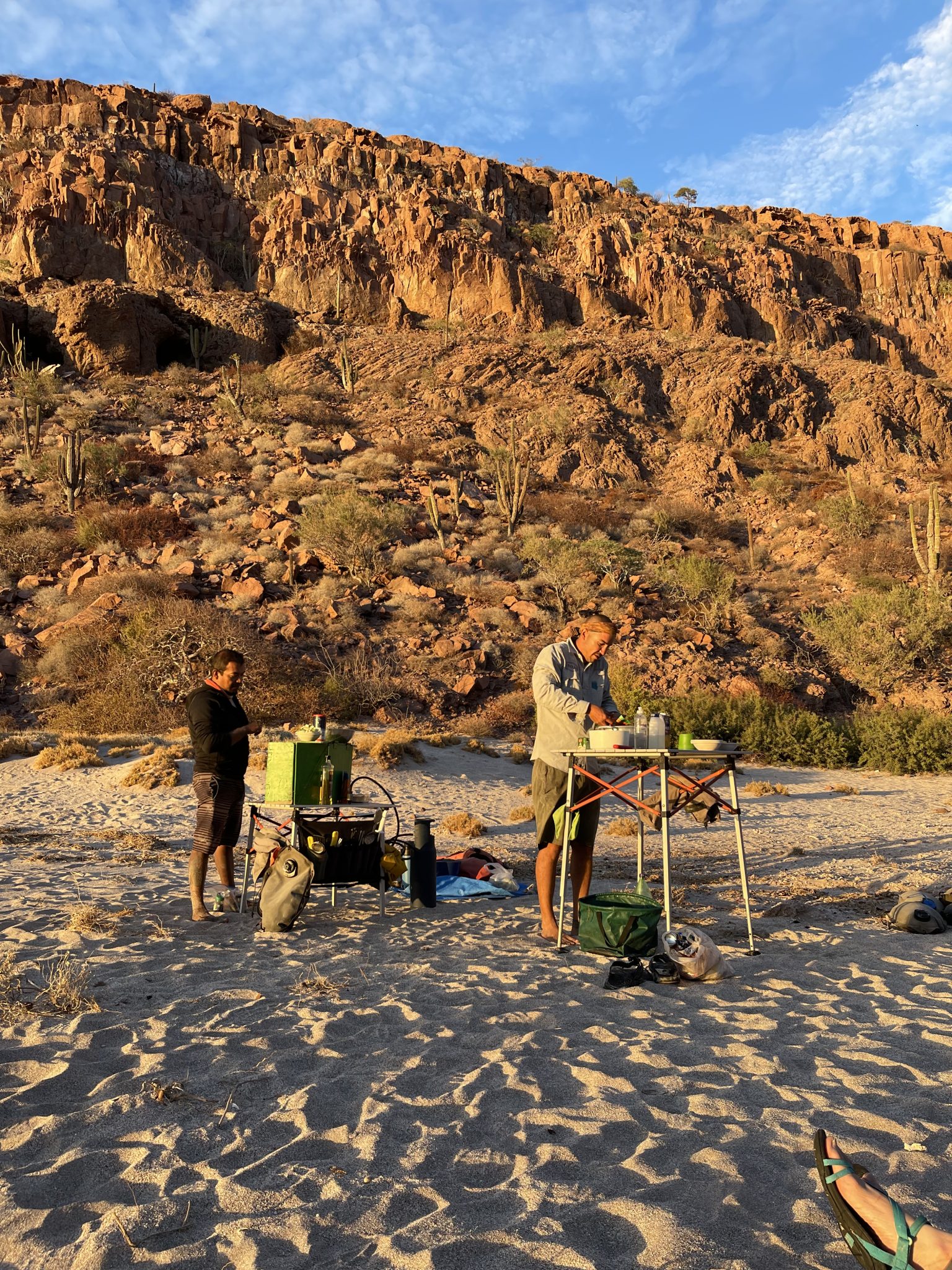
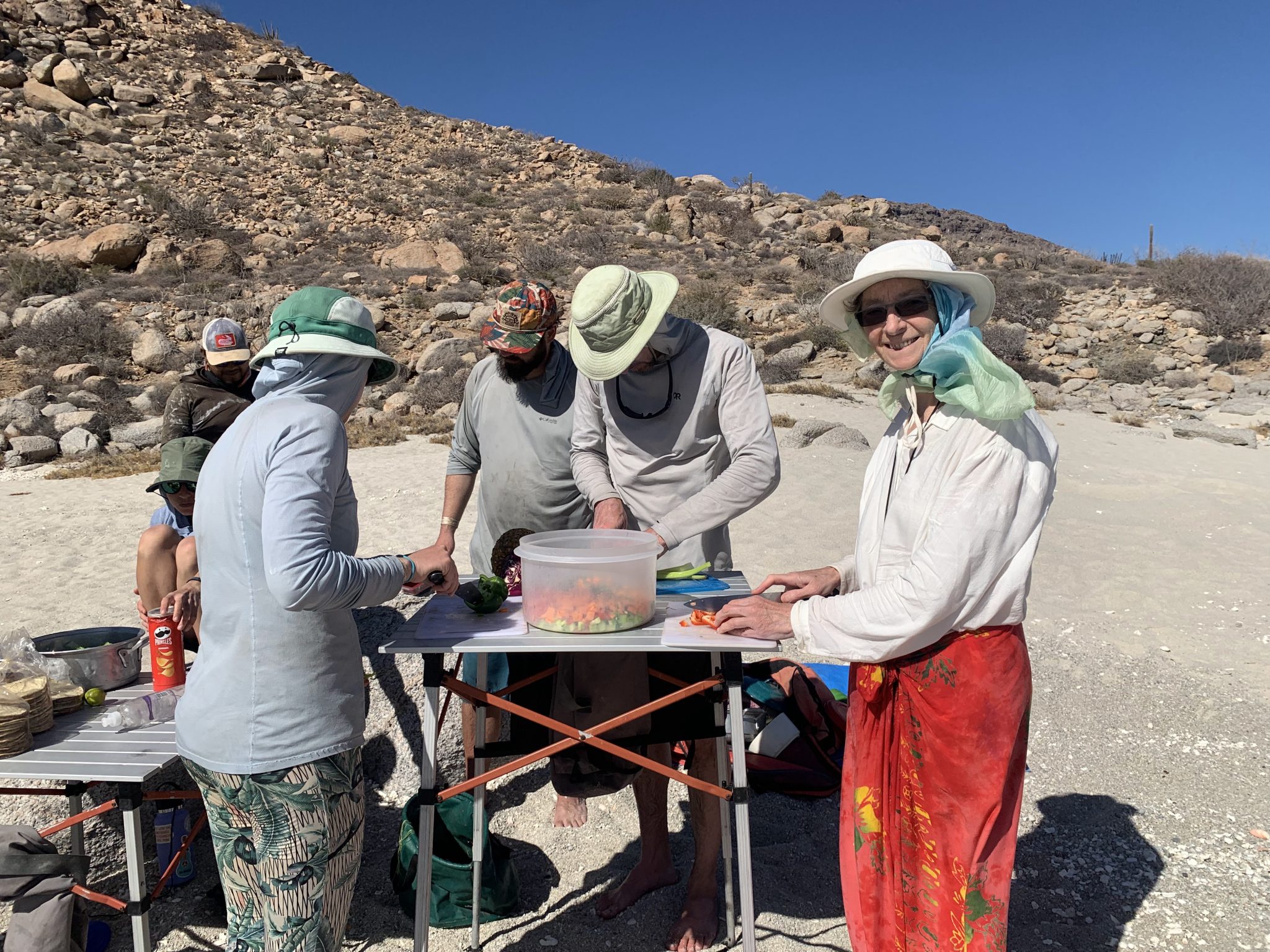
Day 2: 12 km
We rise for coffee at 6:30 and breakfast at 7:00, setting off at 9:00 as usual.
Before lunch, Nic, a fishing guide in Canada, catches a triggerfish. Within minutes, Tulio has filleted the fish and prepared ceviche (“Baja sushi”), which we eat immediately. My wife Diane, who has a high standard when it comes to food, declares it delicious, much better than what we had at a restaurant in La Paz.
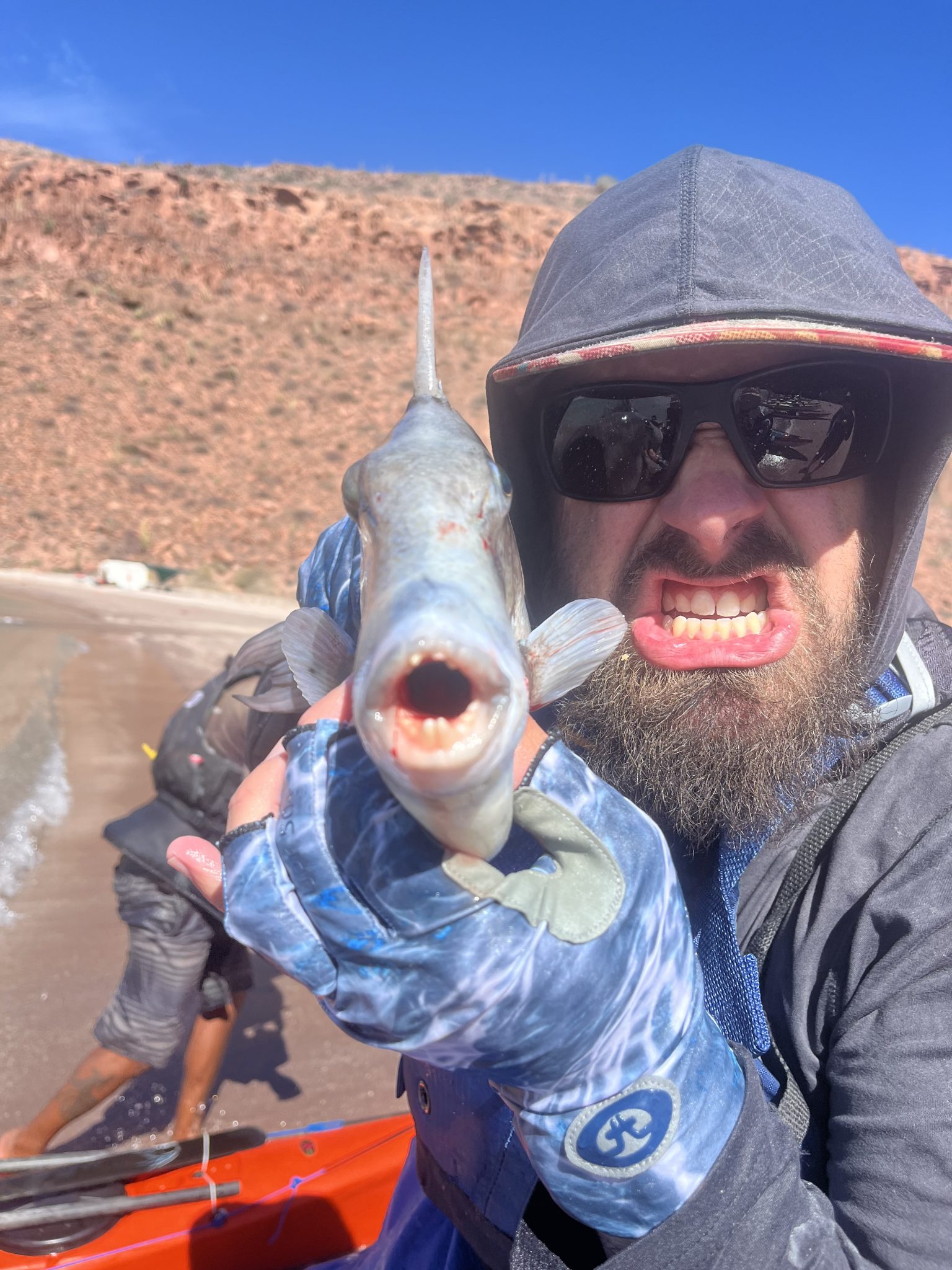
After lunch, two activities are on offer: snorkelling or a hike. Later, we paddle another half hour to our campsite. As with all campsites on this trip, we have the beach to ourselves.
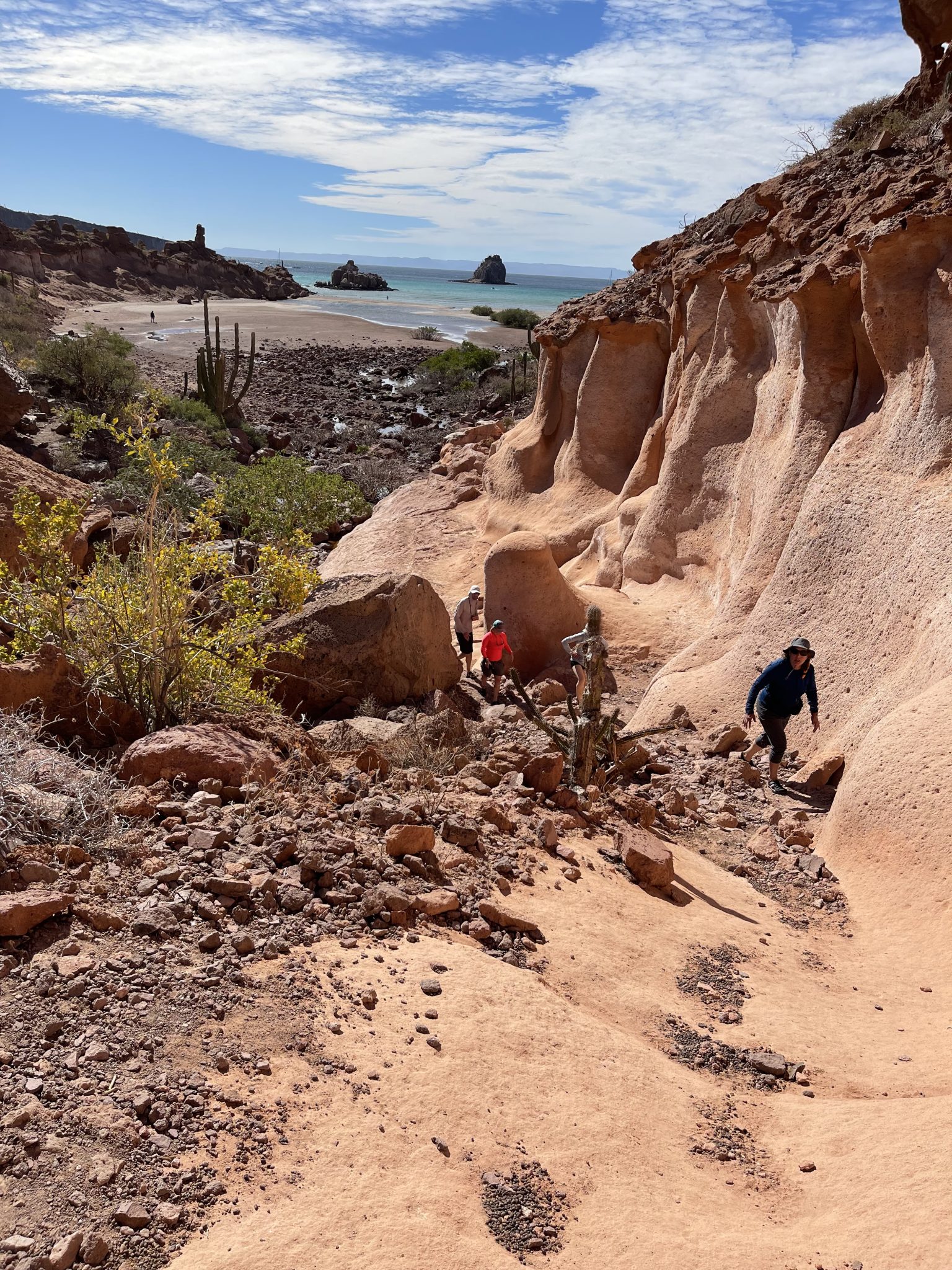
After dark, I use an ultraviolet (UV) flashlight to search the rocks and bushes around camp for scorpions. In the daytime, they are elusive. But at night, they can’t help glowing like tiny neon signs in the UV light. You can easily spot the creatures from three metres away. I find only a few.
I learned this trick from a guide on a previous trip to another Baja island. On that trip, I found a scorpion on the sand just where I was planning on setting up my tent. The sting of one of these scorpions is said to be painful but not life-threatening, unless you have an allergic reaction.
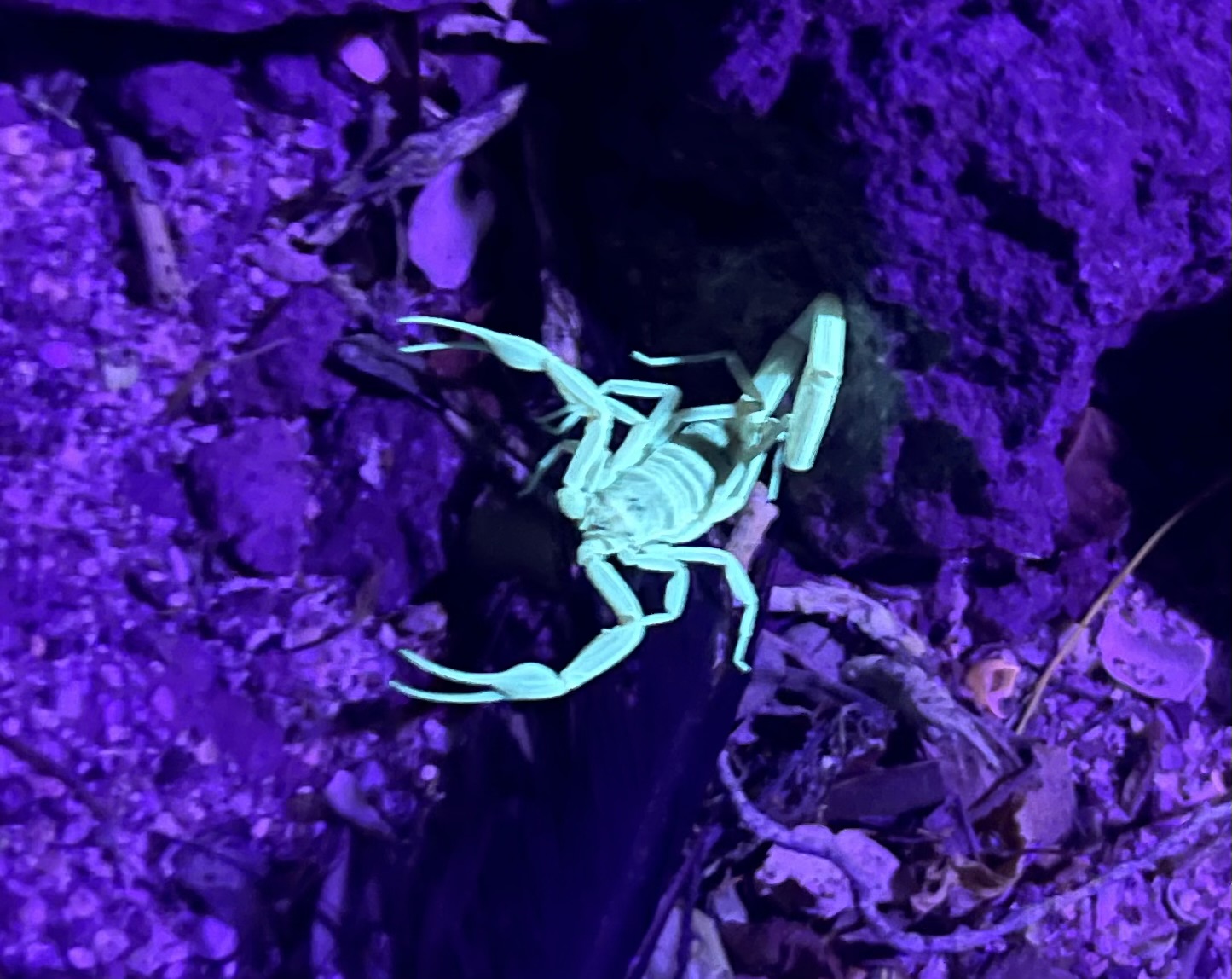
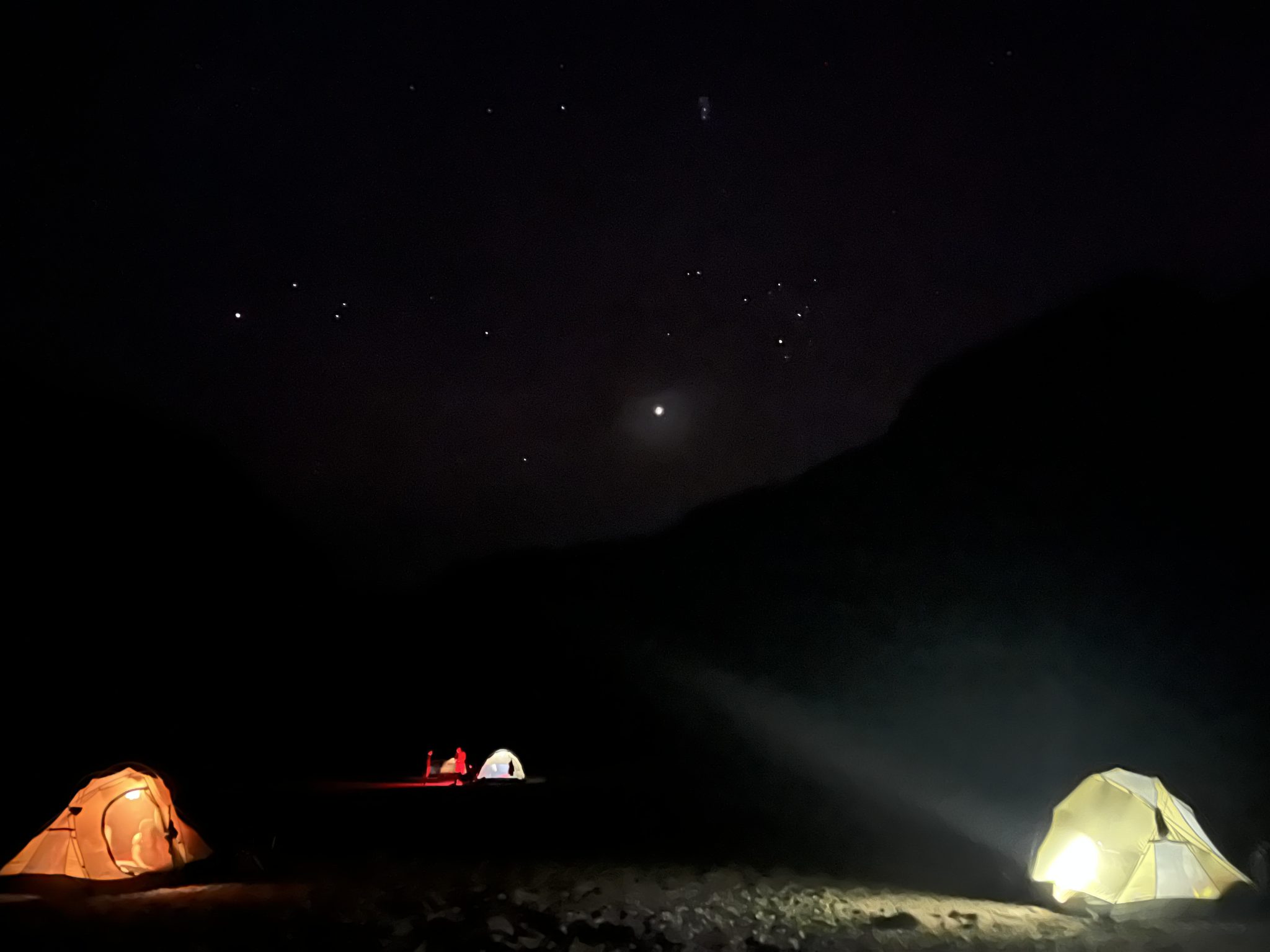
Day 3: 13 km
This day follows the pattern of the others: rise for morning coffee and breakfast, break camp and paddle to a new secluded bay, snorkel for a while, then have lunch.
Snorkelling, I see my first guineafowl puffer fish. This fish is named for its colouration, dark blue with white dots, similar to the guineafowl birds common in sub-Saharan Africa. I had seen the birds years ago on a trip to Zimbabwe. This fish also has a yellow variant.
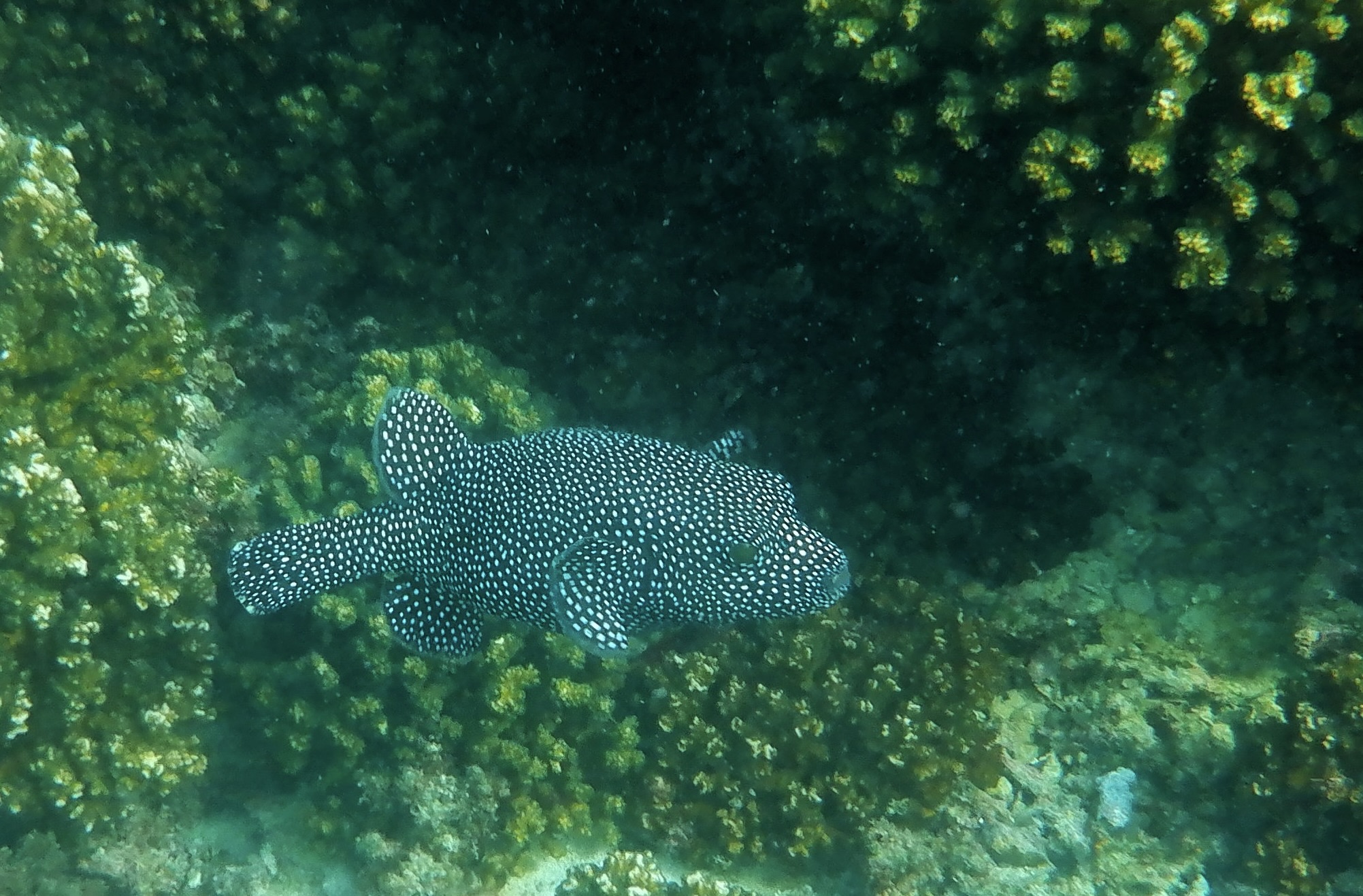
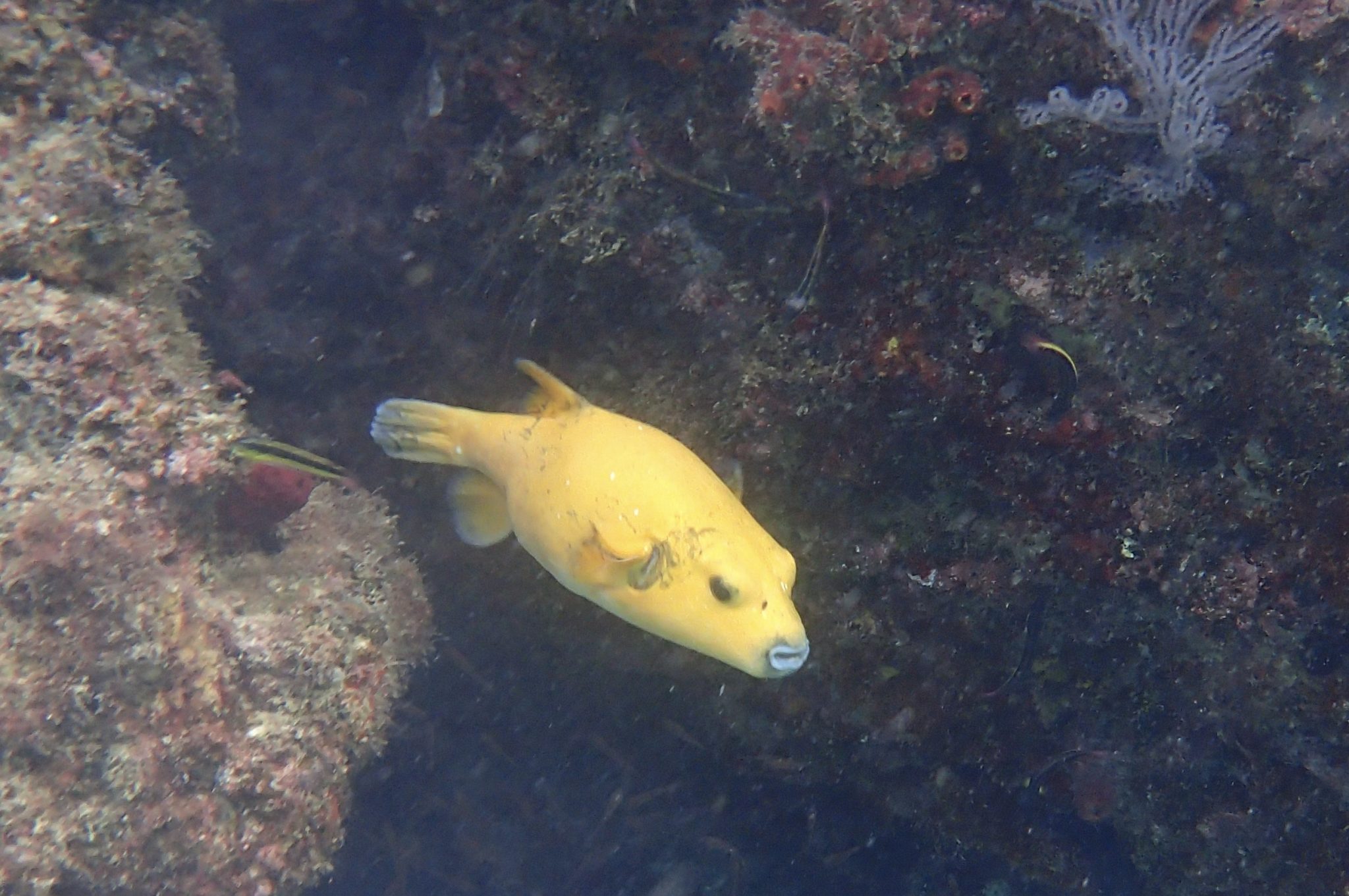
After lunch, we take a short hike. The cacti stand as silent sentries. Small birds flit here and there. Tulio tells us that the island has not had rain for over a year. I fall behind the group, and suddenly spot an owl sleeping in a rocky crevice. I need to let everybody know! While Diane snaps a quick picture, I yell to the others: Hey, an owl! Of course, the bird awakes and flies off before anyone can see it. Later, there is a debate about whether it could have been a great horned owl. At home, iNaturalist confirms this identification.
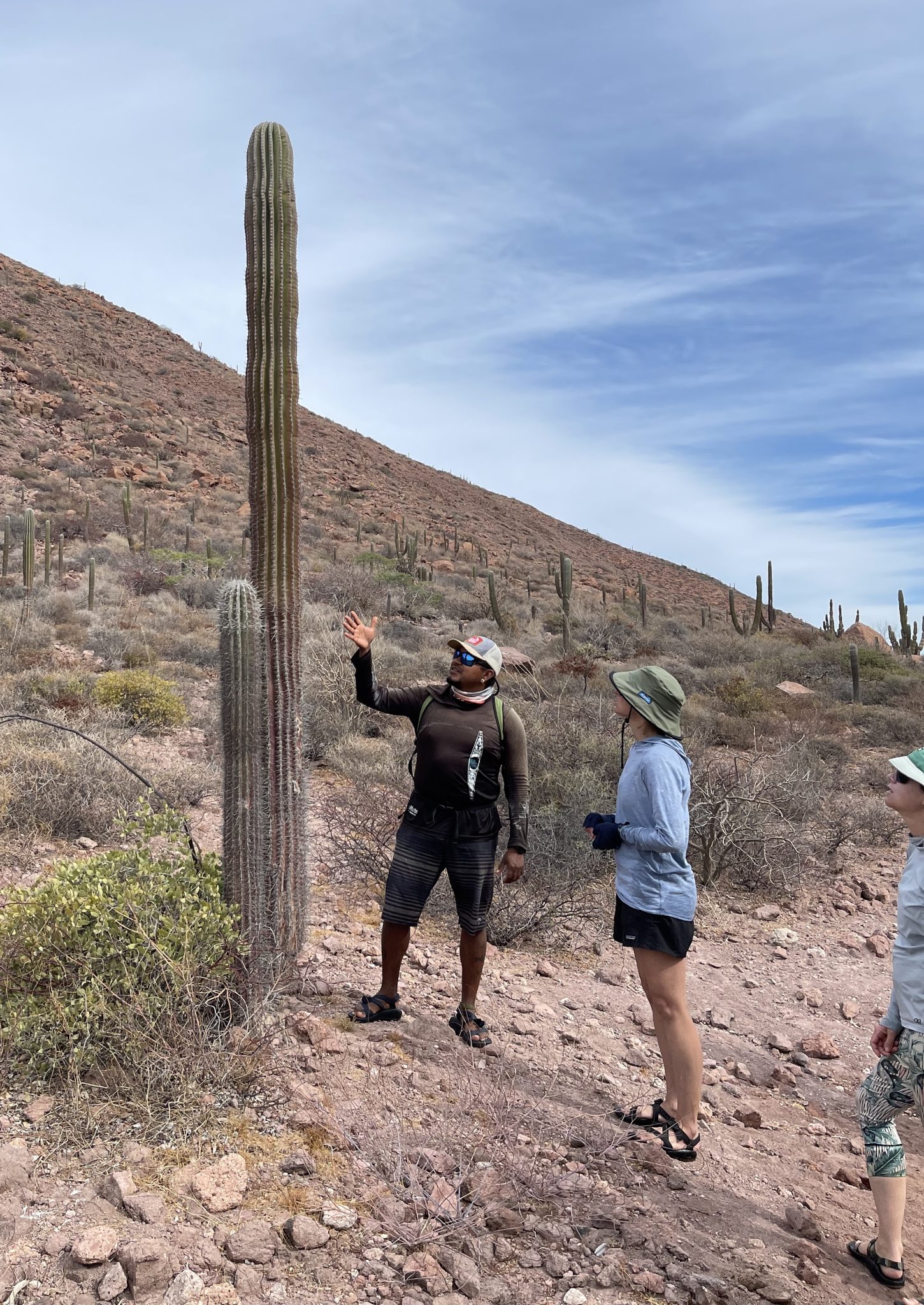
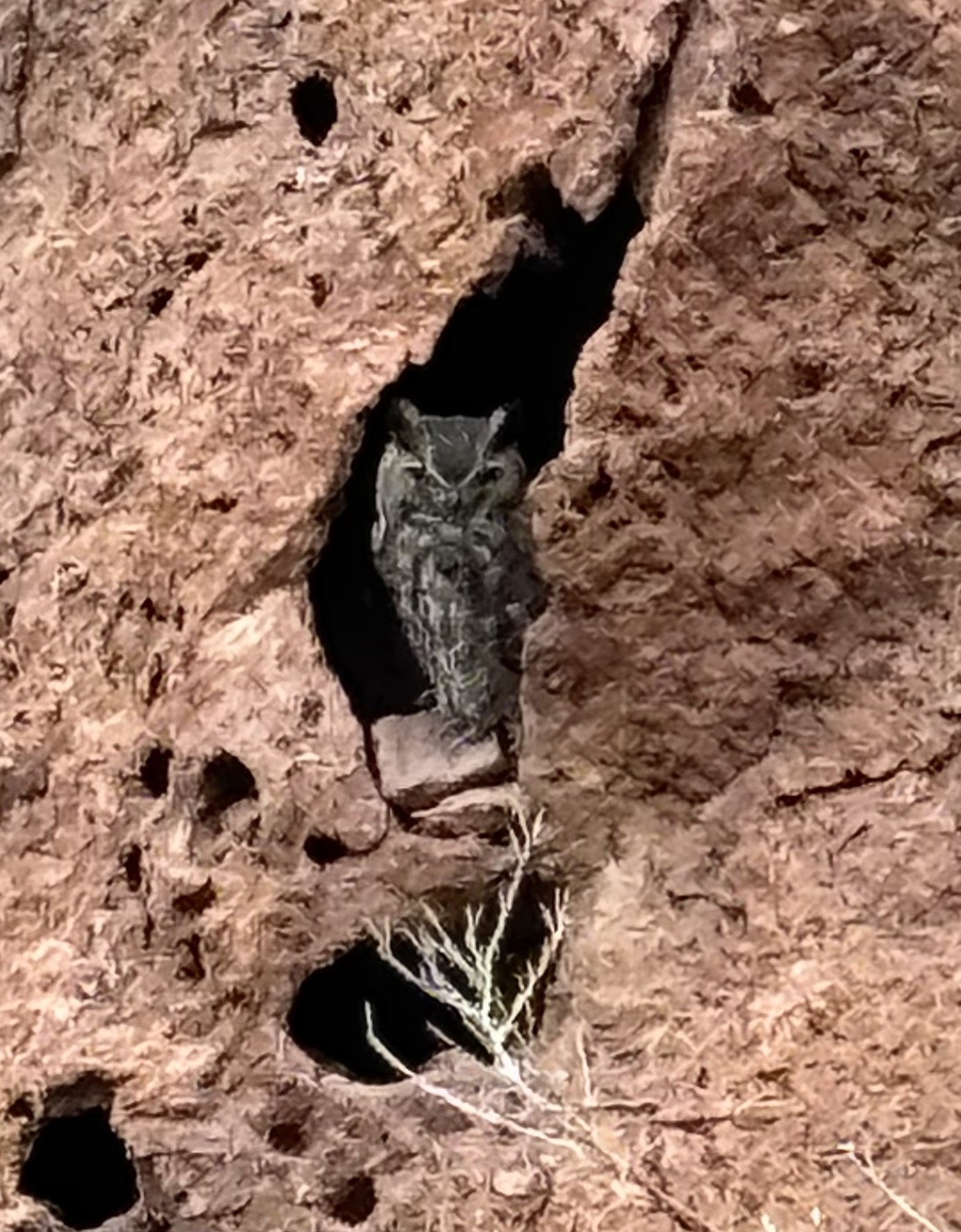
After lunch, we paddle to our next campsite, where we will stay for two nights.
Day 4: 0 km
This is resupply day. The panga arrives at 9:30, and we form a chain from boat to beach to unload fresh supplies, including a cooler of cold beer and other beverages. We climb aboard the panga for a trip to Los Islotes, the sea lion islet off the northern tip of Isla Partida, which neighbours Isla Espiritu Santo.
Snorkelling with sea lions is a popular day trip out of La Paz. We join many other groups, some snorkelling and some scuba diving. Our guides ask us to stick together, and not to pursue the sea lions — let them approach us. And they do! The older ones bask on the rocks, but the younger ones zoom here and there, spiralling and twisting beneath us. Two chase each other, blowing streams of tiny bubbles. Once, I hear a sharp exhalation, and pop up my head to see a young sea lion staring at me from a metre away.
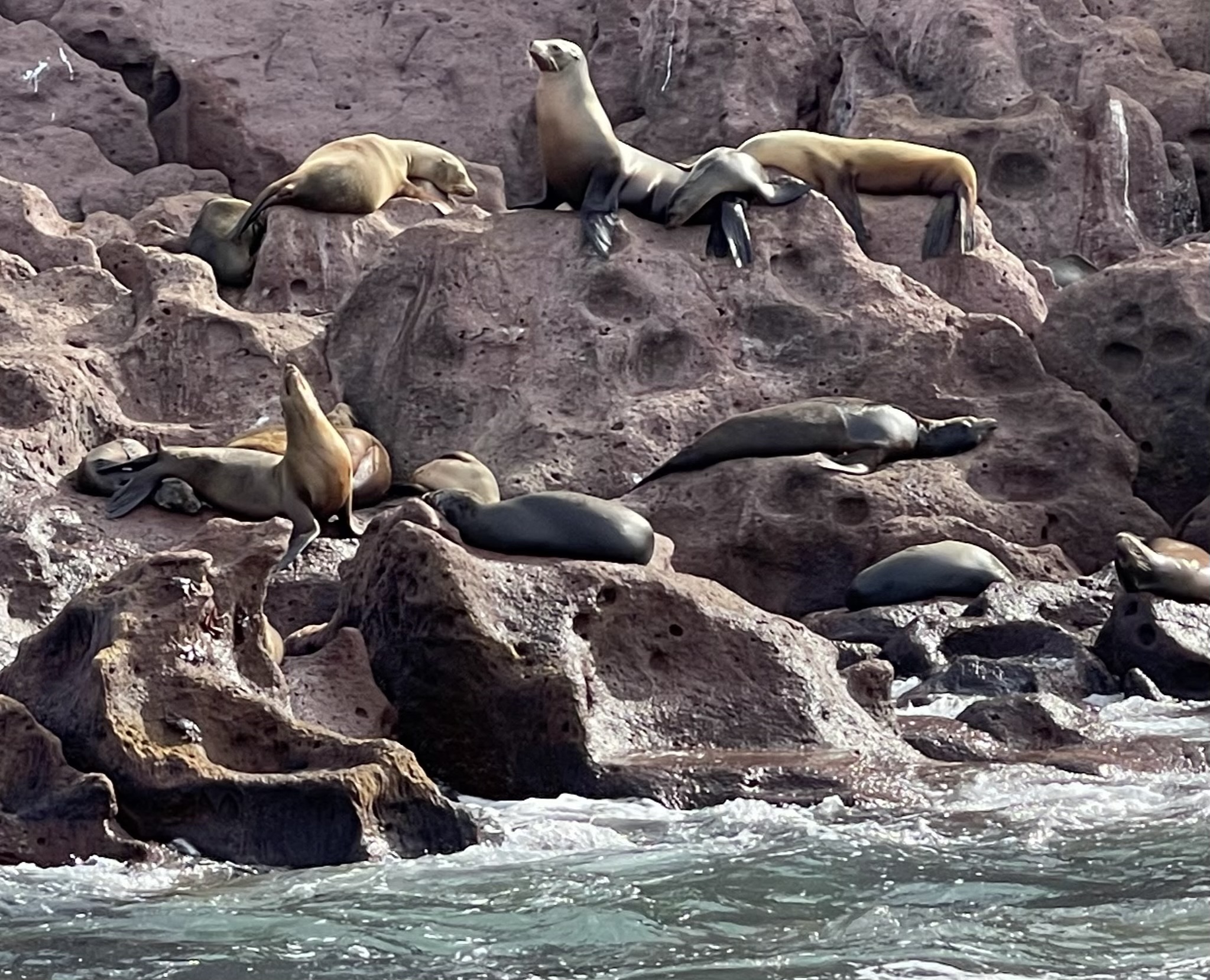
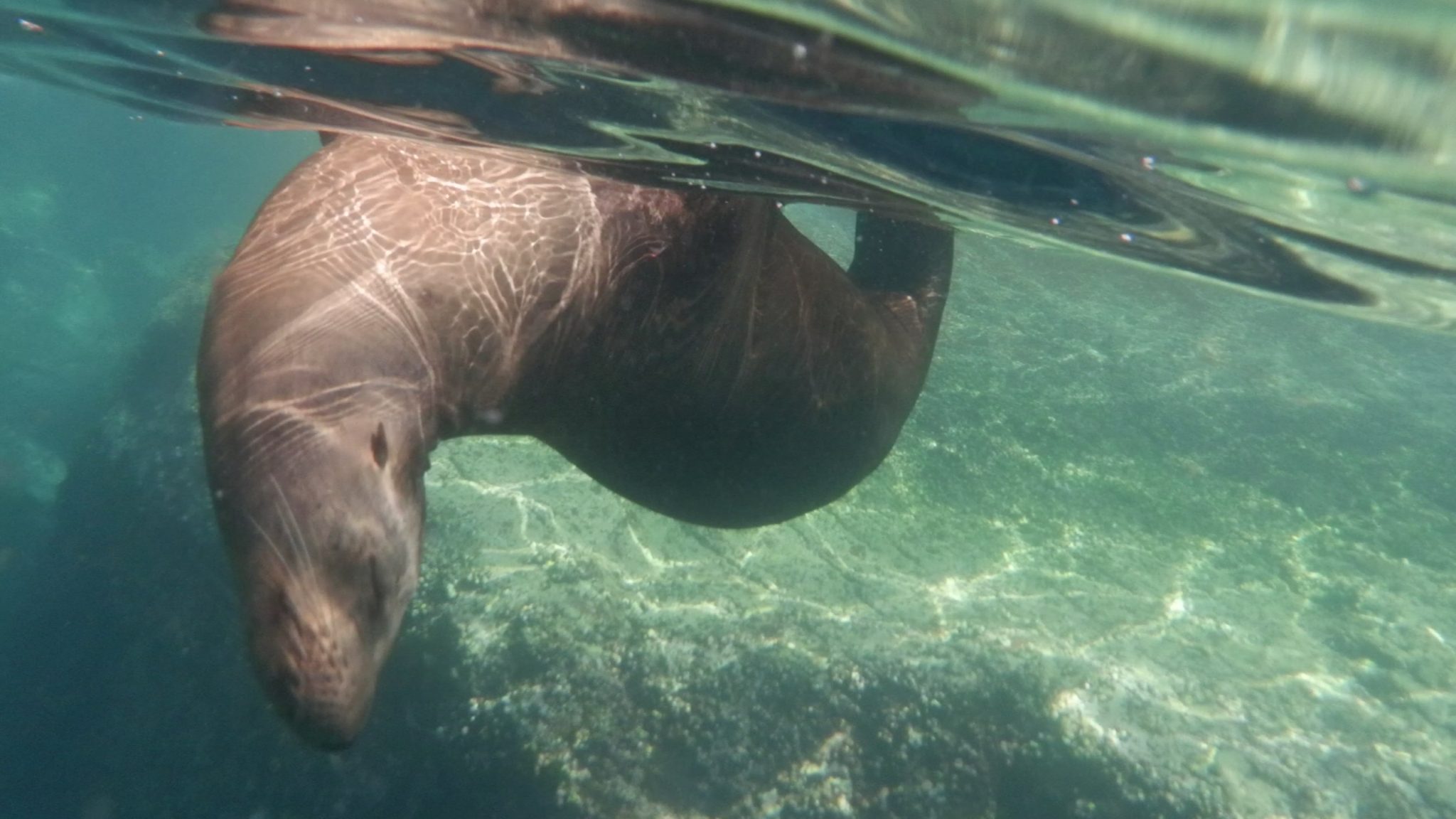
On the return to our campsite via panga, we see a large school of jumping rays. They fly over a metre out of the water.
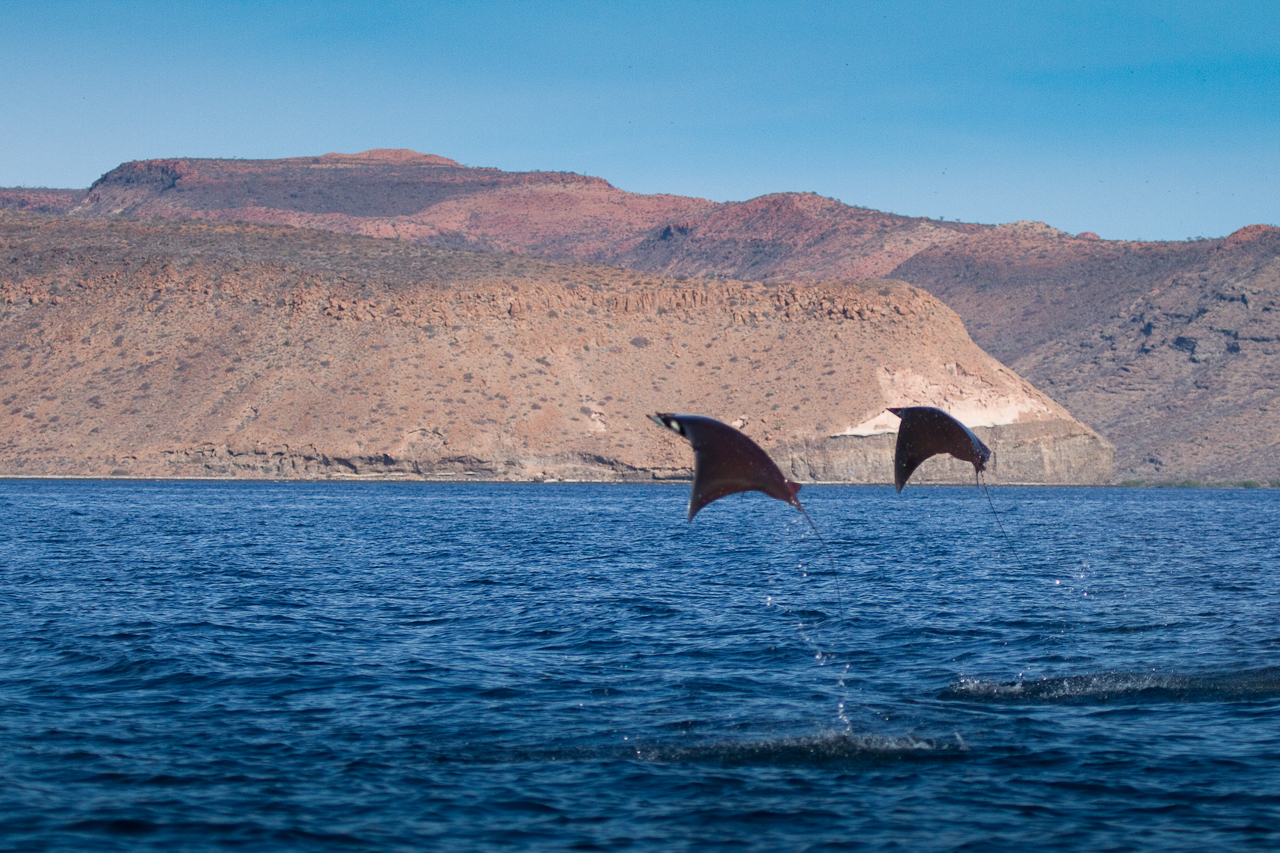
Snorkelling at camp that afternoon, I see a moray eel. It stays close to its rocky lair, which is good, as I understand they can deliver a nasty bite if threatened.
After dinner, our guides let us know that tomorrow will have an early start. We will try to avoid afternoon winds. Breakfast will be at 6 a.m.
Before bed, I go down to the water to brush my teeth. Standing ankle-deep, I notice, in the beam of my headlamp, a moray eel approaching. I hurriedly step out of the water and grab my phone. I get a good half-minute video. Later, I learn that this behaviour is well-known. These nocturnal hunters emerge and swim around at night seeking prey.
Day 5: 11 km
After an early breakfast, we set off by 8 a.m. We are trying to make it around Isla Partida this morning, but the wind is against us. We paddle for well over an hour against the wind and arrive at another sea lion rock. Here, our guides break the news that we are going to give up on our goal of getting around Isla Partida. We will turn back and continue our circumnavigation of Espiritu Santo via the passage between Partida and Espiritu Santo.
Before entering the passage, we stop at a beach for lunch and snorkelling. I see several trumpetfish.
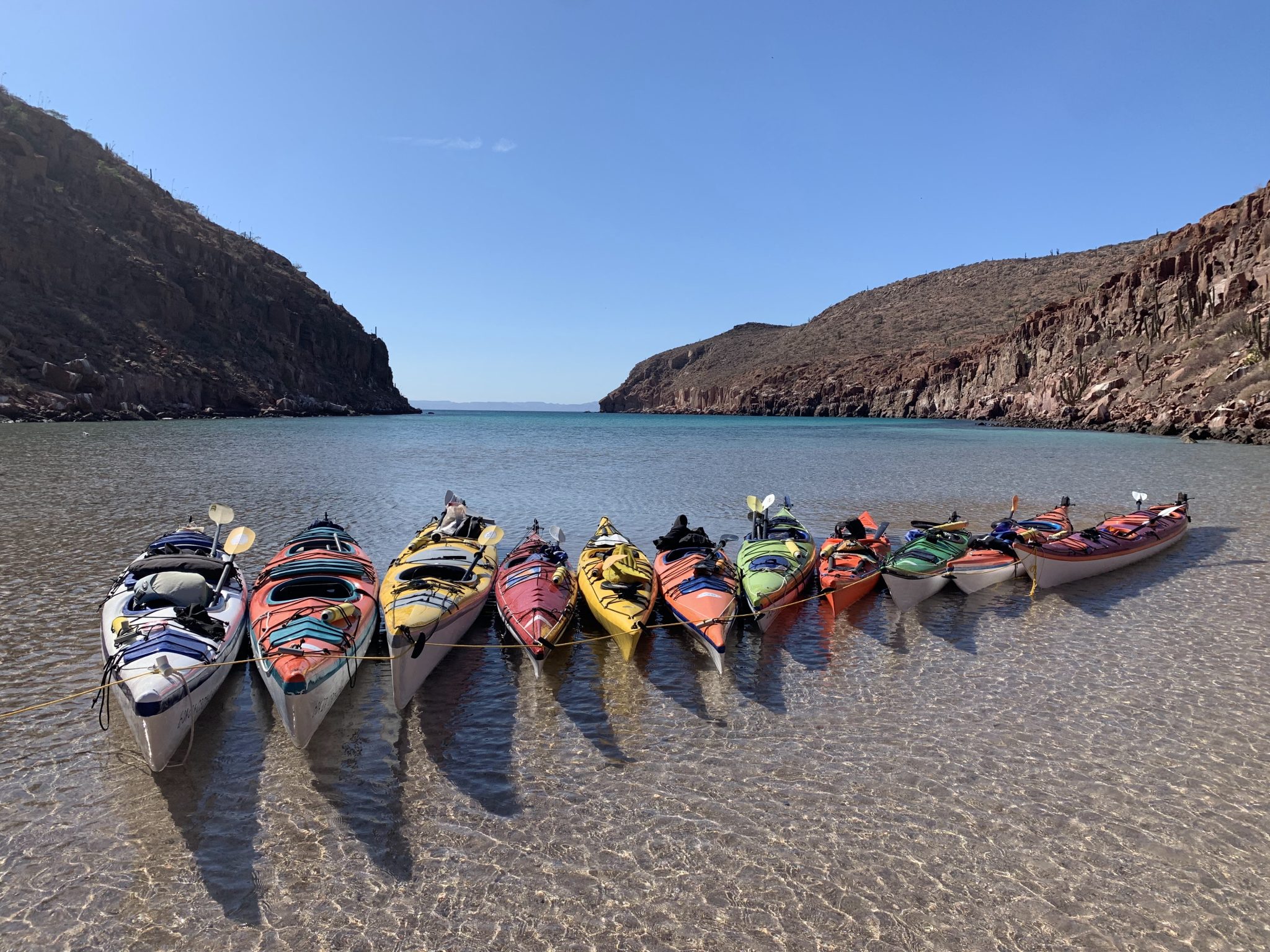
After lunch, we paddle to the passage between Partida and Espiritu Santo, where there is a fishermen’s camp on the beach. On the way, we paddle through another school of mobula rays, jumping one to two metres out of the surrounding water, some within ten metres.
Before dinner, the guides on vacation challenge each other to roll a double kayak with two people in it. The feat is managed several times, to great applause from the rest of us.
After dinner, Tulio outlines route options for tomorrow: one if the wind keeps up, and another if it abates.
Day 6: 22 km
We set off at 9 a.m. down the east coast of the island. The wind is at our backs, and we are in following seas. To keep my kayak pointed in a consistent direction, I dig deep and paddle hard, and end up in the lead, an unaccustomed position.
The coast on this side of the island is totally different. Instead of beaches, we pass cliffs with no easy landing spots. I now appreciate why the guides have planned our route as a clockwise circumnavigation. A counterclockwise route would have had our new group setting off on day one beside cliffs and against the wind.
After a couple of hours, we find a beach, where we stop for lunch and snorkelling. Then it’s off again, till by dinner time we arrive at a lovely sand beach on the south end of the island, with a view of La Paz. In one day, we have paddled the entire east coast of the island. It had taken us four days to paddle the west coast.
Day 7: 8 km
We wake as usual for breakfast at 7 a.m. It is bittersweet, as we know this will be our last day. All we have to do is cross the channel between Espiritu Santo and La Paz, a distance of about 6 km. It is a surf landing on a sand beach. We line up and wait for our turn to land. I mistime my landing and find myself, for the first time since our deliberate capsize on day one, half-rolled over and in the water. No worries, our guides are there to pull me out. The trip is complete. All that remains is unpacking, sorting gear, a last night in a hotel, a day of sightseeing in La Paz, a celebratory dinner, and goodbyes.
This was a fabulous trip. I recommend the Sea of Cortez to any kayaker looking for a sunny escape from the BC winter rainy season.
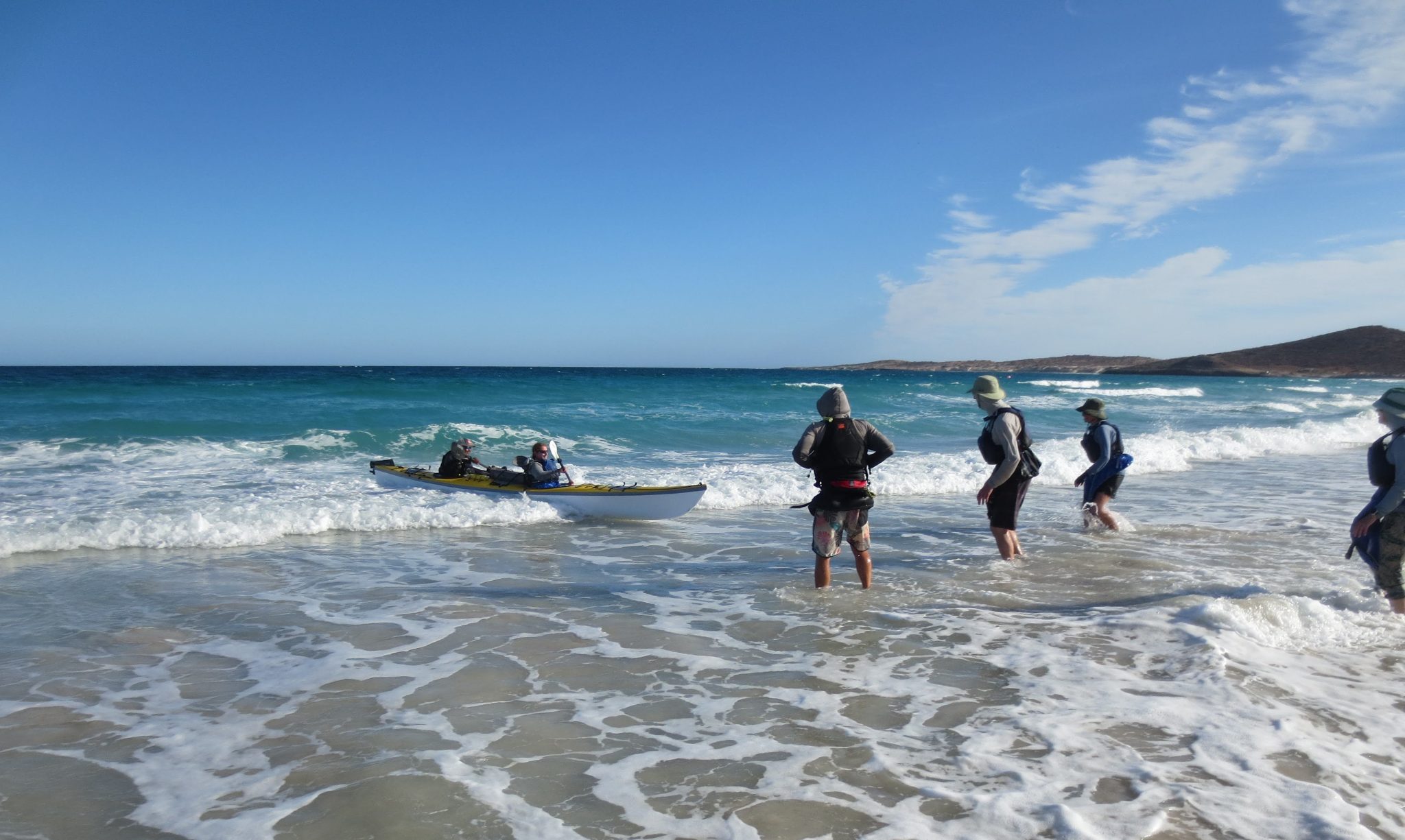
If you go
The Baja kayaking season runs from October through May. We flew direct from Vancouver to San Jose del Cabo and took a bus from a local company, Águila, a couple of hours north to La Paz. The bus was comfortable and modern.
We booked the tour through Black Feather in Canada, which contracted with the Mexican company Indomito360 in La Paz.
Things we were happy we brought
- Quick-dry shorts
- Quick-dry synthetic underwear
- Quick-dry buff
- Hooded long-sleeved quick-dry shirt
- Paddling gloves (for sun protection)
- Ball cap
- Water shoes
- Sleeping bag
- A good power bank for phones and headlamps
- Mask and snorkel
- Light puffy jacket or vest, to wear on cool mornings and stuff into a pillowcase at night
- UV flashlight for scorpion-spotting
Provided by the outfitter
- Tent
- Sand anchors
- Sleeping pad
Rented from the outfitter
- Flippers
- Shorty wetsuits
- Camp chairs
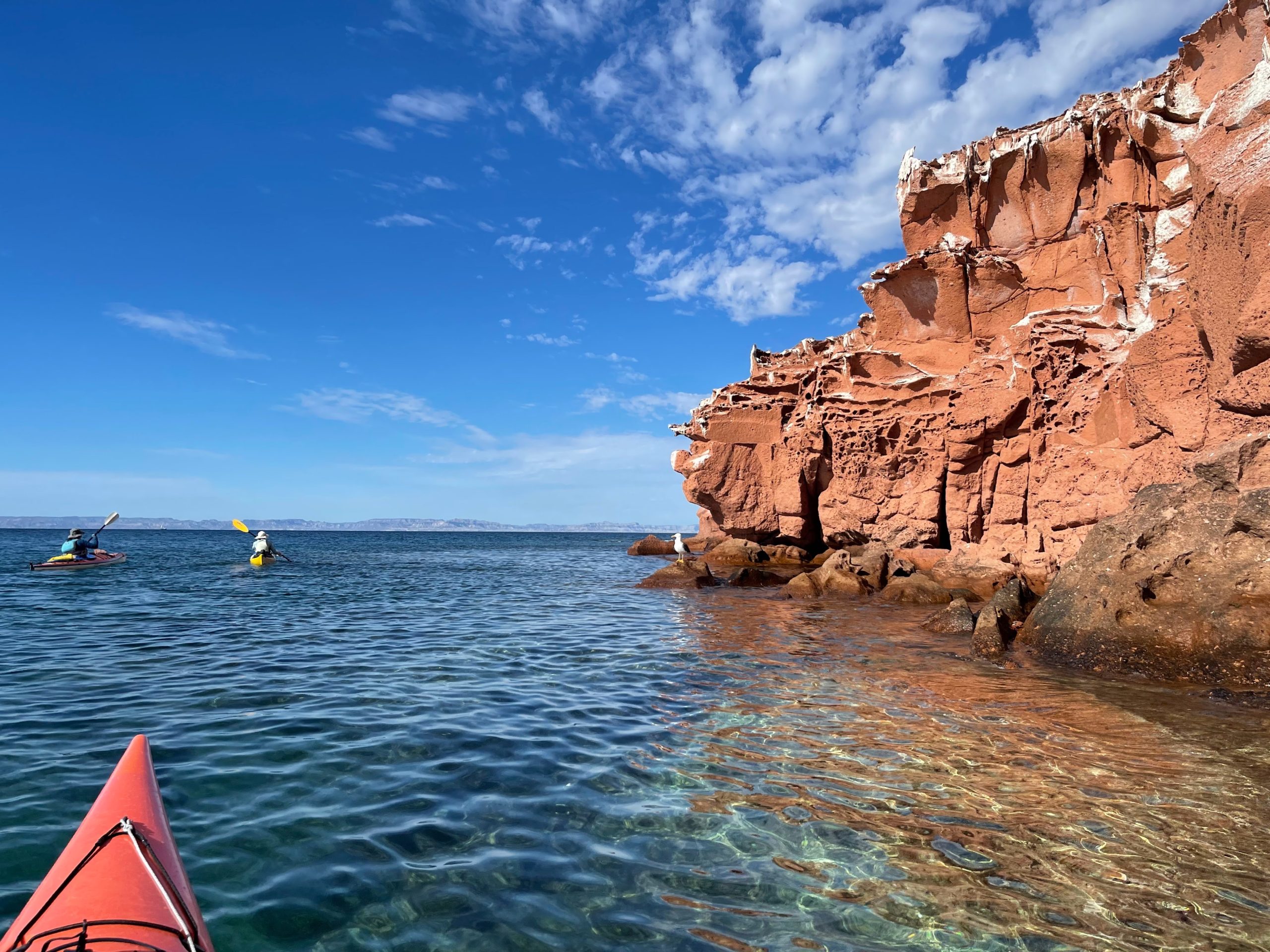
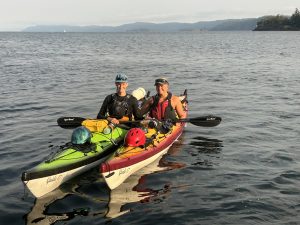
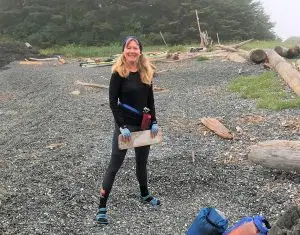
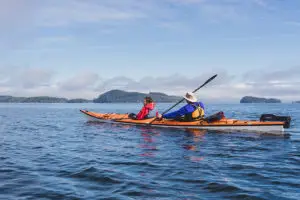
I loved reading your trip report, Robin. It brought back fond memories of the trip we did with Mar y Aventuras several years ago around Isla Espiritu Santo. I still keep in contact with one of the guides we had on that trip and we returned to La Paz two years ago to connect with friends we made while we were there. It’s a great place to paddle and thanks for sharing your trip details with everyone.
Thanks, Karina! Sounds like you had a great experience there too!
I’ve paddled at that Island. All Baja is amazing and varied. This spring I joined 3 others on an unsupported circumnavigation of Isla de La Guarda in the Sea of Cortez. I arranged a panga to take us there and then pick us up 11 days later. Your trip report and photos are wonderful. How did your water consumption work out? How did you calculate liters per day each?
The west coast near San Ignacio lagoon (whale birthing area) and Scorpion Bay/ San Juanico are great for touring and surfing.
Thanks for the feedback, Ken! Your recent self-supported trip sounds wonderful. With regard to water, each person carried one 10L Dromedary bag of water, and we refilled once mid-trip when the panga came for resupply and to take us to the sea lions. So it was about 3L per person per day. This was organized by the guides, and we trusted their judgement. We also had some beverages such as beer and juice.
Fantastic trip report with great photos. Thanks for sharing!
Thanks, Jerry!